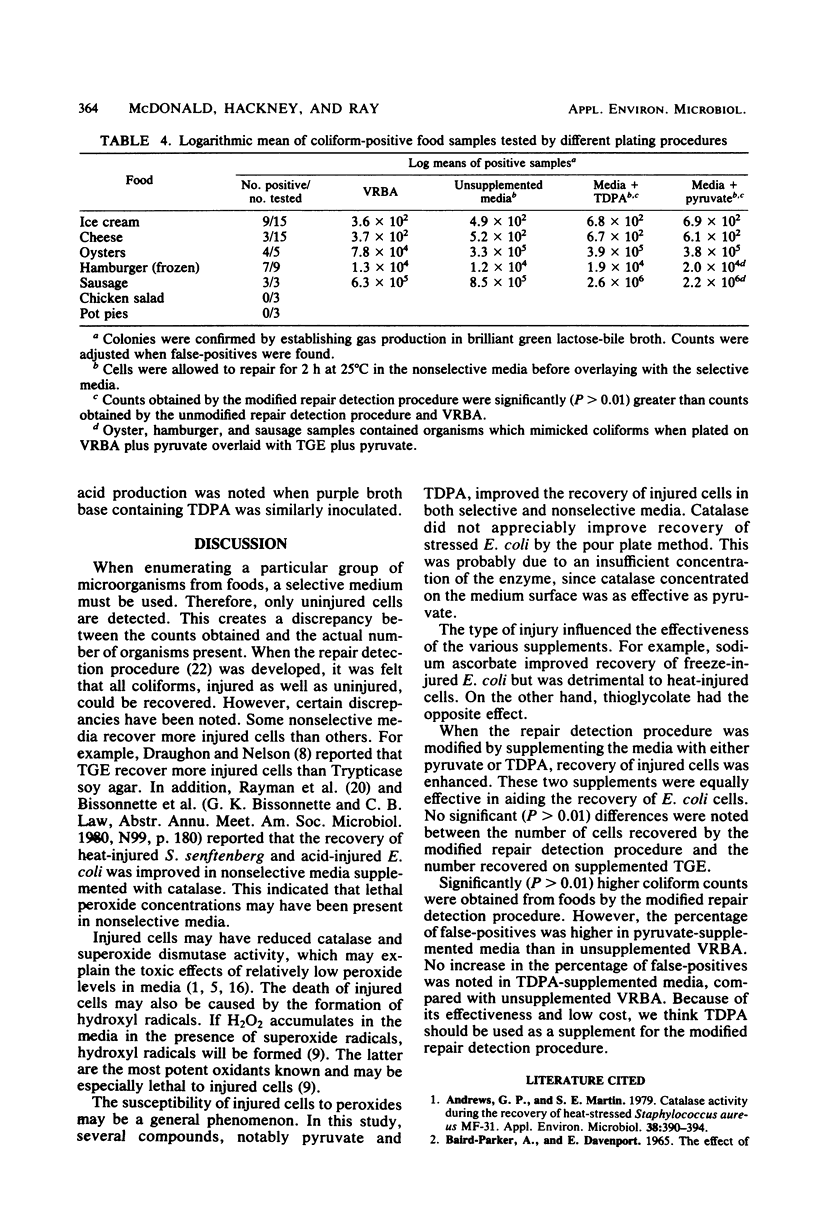Abstract
Escherichia coli LSUFS was injured either by freezing at -10 degrees C or by heating at 57 degrees C for 12 min. Surviving cells were recovered on nonselective tryptone-glucose extract agar and selective violet red bile agar supplemented with compounds that degrade hydrogen peroxide or block its formation. Various concentrations of the following compounds were tested: sodium pyruvate, 3,3'-thiodipropionic acid, catalase, ascorbic acid, potassium permanganate, sodium thioglycolate, dimethylsulfoxide, ethoxyquin, n-propyl gallate, alpha-tocopherol sodium metabisulfite, and ferrous sulfate. Sodium pyruvate and 3,3'-thiodipropionic acid, when added to either medium, significantly (P greater than 0.01) increased recovery of injured cells. More than 90% of the heat-injured cells and 40 to 90% of the freeze-injured cells failed to grow on unsupplemented tryptone-glucose extract agar. Supplementation of violet red bile agar increased recovery, but the counts remained considerably lower than the tryptone-glucose extract agar counts. The repair detection procedure of Speck et al. (M. Speck, B. Ray, R. Read, Jr., Appl. Microbiol. 29:549-550, 1975) was greatly improved by the addition of pyruvate or 3,3'-thiodipropionic acid. However, when this improved repair detection procedure was applied to foods, pyruvate-supplemented media showed some false-positives. We therefore recommend that 3,3'-thiodipropionic acid be used to supplement media in the repair detection procedure.
Full text
PDF





Selected References
These references are in PubMed. This may not be the complete list of references from this article.
- Andrews G. P., Martin S. E. Catalase activity during the recovery of heat-stressed Staphylococcus aureus MF-31. Appl Environ Microbiol. 1979 Sep;38(3):390–394. doi: 10.1128/aem.38.3.390-394.1979. [DOI] [PMC free article] [PubMed] [Google Scholar]
- BARRY V. C., CONALTY M. L., DENNENY J. M., WINDER F. Peroxide formation in bacteriological media. Nature. 1956 Sep 15;178(4533):596–597. doi: 10.1038/178596a0. [DOI] [PubMed] [Google Scholar]
- Bucker E. R., Martin S. E. Effect of free-radical scavengers on enumeration of thermally stressed cells of Staphylococcus aureus MF-31. Appl Environ Microbiol. 1982 May;43(5):1020–1025. doi: 10.1128/aem.43.5.1020-1025.1982. [DOI] [PMC free article] [PubMed] [Google Scholar]
- Carlsson J., Nyberg G., Wrethén J. Hydrogen peroxide and superoxide radical formation in anaerobic broth media exposed to atmospheric oxygen. Appl Environ Microbiol. 1978 Aug;36(2):223–229. doi: 10.1128/aem.36.2.223-229.1978. [DOI] [PMC free article] [PubMed] [Google Scholar]
- Hackney C. R., Ray B., Speck M. L. Repair detection procedure for enumeration of fecal coliforms and enterococci from seafoods and marine environments. Appl Environ Microbiol. 1979 May;37(5):947–953. doi: 10.1128/aem.37.5.947-953.1979. [DOI] [PMC free article] [PubMed] [Google Scholar]
- Hartman P. A., Hartman P. S., Lanz W. W. Violet red bile 2 agar for stressed coliforms. Appl Microbiol. 1975 Apr;29(4):537–539. doi: 10.1128/am.29.4.537-539.1975. [DOI] [PMC free article] [PubMed] [Google Scholar]
- Hoffman P. S., George H. A., Krieg N. R., Smibert R. M. Studies of the microaerophilic nature of Campylobacter fetus subsp. jejuni. II. Role of exogenous superoxide anions and hydrogen peroxide. Can J Microbiol. 1979 Jan;25(1):8–16. doi: 10.1139/m79-002. [DOI] [PubMed] [Google Scholar]
- Martin S. E., Flowers R. S., Ordal Z. J. Catalase: its effect on microbial enumeration. Appl Environ Microbiol. 1976 Nov;32(5):731–734. doi: 10.1128/aem.32.5.731-734.1976. [DOI] [PMC free article] [PubMed] [Google Scholar]
- McCord J. M., Fridovich I. The utility of superoxide dismutase in studying free radical reactions. I. Radicals generated by the interaction of sulfite, dimethyl sulfoxide, and oxygen. J Biol Chem. 1969 Nov 25;244(22):6056–6063. [PubMed] [Google Scholar]
- Ray B., Speck M. L. Enumeration of Escherichia coli in frozen samples after recovery from injury. Appl Microbiol. 1973 Apr;25(4):499–503. doi: 10.1128/am.25.4.499-503.1973. [DOI] [PMC free article] [PubMed] [Google Scholar]
- Ray B., Speck M. L. Plating procedure for the enumeration of coliforms from dairy products. Appl Environ Microbiol. 1978 Apr;35(4):820–822. doi: 10.1128/aem.35.4.820-822.1978. [DOI] [PMC free article] [PubMed] [Google Scholar]
- Rayman M. K., Aris B., El Derea H. B. The effect of compounds which degrade hydrogen peroxide on the enumeration of heat-stressed cells of Salmonella senftenberg. Can J Microbiol. 1978 Jul;24(7):883–885. doi: 10.1139/m78-146. [DOI] [PubMed] [Google Scholar]
- Scheusner D. L., Busta F. F., Speck M. L. Injury of bacteria by sanitizers. Appl Microbiol. 1971 Jan;21(1):41–45. doi: 10.1128/am.21.1.41-45.1971. [DOI] [PMC free article] [PubMed] [Google Scholar]
- Speck M. L., Ray B., Read R. B., Jr Repair and enumeration of injured coliforms by a plating procedure. Appl Microbiol. 1975 Apr;29(4):549–550. doi: 10.1128/am.29.4.549-550.1975. [DOI] [PMC free article] [PubMed] [Google Scholar]


